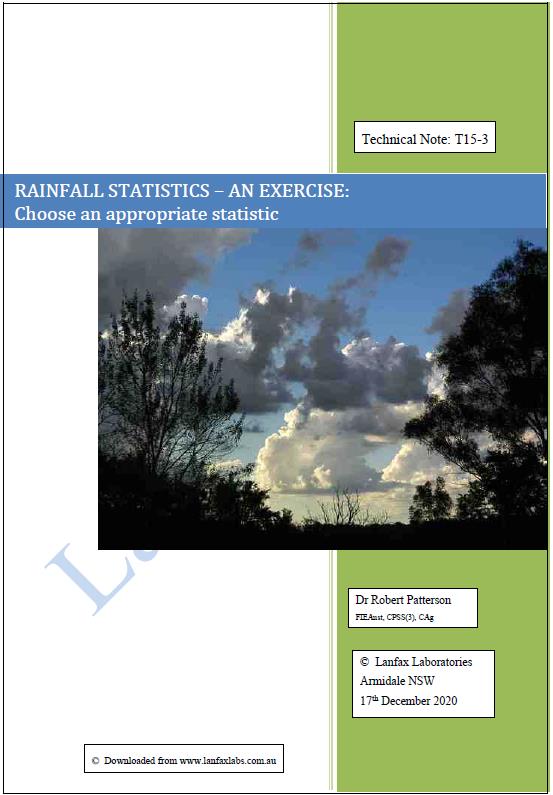Simplified Rainfall Statistics
Overview
On-site wastewater management planning requires that the discharge of household wastewater, when disposed to land either through trenches or by irrigation, be matched with the natural inputs of rainfall and the losses by evapotranspiration, deep drainage and changes to the soil moisture storage. Simple arithmetic calculations can be performed or computer spreadsheets be set up to undertake calculations for daily or monthly modelling.
While the rainfall inputs to the water balance model come from historical data they may or may not be an indication of what rainfall frequency, intensity and daily total we may experience in the future. Yet we 'pretend' that modelling historical rainfall gives us a view to the future. Since rainfall is random on a daily, monthly or annual basis, there are some statistics that we may use to 'pretend' that our modelling is at least a view to the future, blinkered and distorted as it may be. We can, however, take some comfort that by minimising known statistical errors our modelling may serve as a guide.
In the attached document, rainfall statistics are discussed in simple terms with explanation and examples of 'acceptable' inputs to a modelling exercise. The water balance modelling component for wastewater assessments is not a stand alone prediction of sizing an effluent disposal area, rather combining with knowledge of the chemistry of the inputs (domestic wastewater) and the interactions with the various physical, chemical and biological properties of the soil and the wider landscape. We aim to return the effluent to the hydrologic cycle through evapotranspiration and drainage, while minimising the soil water storage component to acceptable levels.
 The
document provides a simple overview to on-site wastewater statistics and
challenges the use of rainfall statistics that are more likely to lead to
failure of the land application area.
The
document provides a simple overview to on-site wastewater statistics and
challenges the use of rainfall statistics that are more likely to lead to
failure of the land application area.
One needs to be aware that a less than 50% chance of an adequate land application area may cause serious environmental and health outcomes that are difficult to correct. A boggy patch in the application area is not an ideal outcome.
On the other hand, too large an effluent irrigation area simply alienates an unnecessary large portion of the living area and likely insufficient effluent to maintain a healthy irrigation area.
The document is set out in the following format:
1. Introduction
2. Existing water balance rainfall inputs
3. Available rainfall data
4. Processing the data
5. Statistical summaries
6. Interpretation of data
7. Conclusion
8. References.
Download Simplified Rainfall Statistics click here
When you are confident in your interpretation of an appropriate rainfall statistic, the next paper delves further further statistical considerations for selecting an appropriate rainfall statistic.
Download Rainfall Statistics: Which one to Choose?, click here

1. Introduction
2.Calculating Statistical Ranks
3. Annual Statistical Values
4. Monthly Statistical Values
5.Monthly Statistical Values for Other Towns in NSW
6.Multi-choice Method - years around 70th percentile
7. Variability of Data around 70th percentile
8. Actual Water Balance Outcomes
9. Now What is the Choice of Rainfall Statistic?
10. Conclusion
11 References
Download Rainfall Statistics: Which one to Choose? click here
A third paper provides an exercise in choosing an appropriate statistic. While the exercise uses rainfall data for Armidale in northern NSW, the exercise can be adapted to anywhere in Australia where Bureau of Meteorology's internet resources apply.
Download Rainfall Statistics: An Exercise, click here

1. Introduction
2. Rainfall Statistics - an exercise
3. Improvement in Statistical Choices
4. Calculating Other Percentile Values
5. Choosing the 70th percentile
6. Modelling for all values around 70th percentile
7. Modelling Historical Data
8. Conclusion
9. References
Download Rainfall Statistics: An Exercise Click here